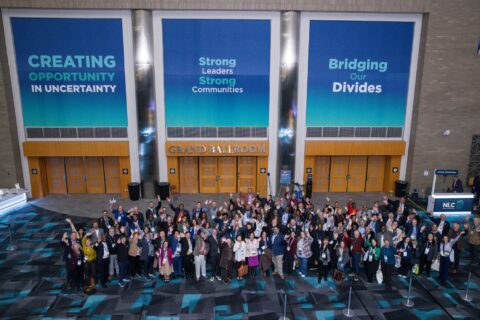Cities, towns and villages across the country are struggling with housing shortages and homelessness – and so are colleges. Homelessness has been on the rise since 2017, experiencing an overall 6 percent increase.1 Even more, the challenges of affordable housing availability are growing due to inflation and COVID-related business closures in addition to the overabundance of luxury buildings in the development of new housing.2 This is a problem that affects communities nation-wide, with nearly 600,000 individuals unhoused as of 2022. Our elected leaders are in need of strong partners to combat this trend. In fact, there is a natural ally in the fight against homelessness and housing insecurity that is already in more than one quarter of cities, towns and villages around the nation – the local college.3
Over 80 percent of college students live in the communities where they attend school. While some schools provide residence halls (at a cost), fewer than 1 in 5 students attending college live on campus – they live in the communities surrounding their campus. And, based on the recently released National Postsecondary Student Aid Study (NPSAS), homeless rates for college students are nearly 1 in 10⏤in other words, of the students attending college or university today, nearly 1.4 million are experiencing homelessness. The rates are similar regardless of the type of college these students attend. The notable exceptions are those attending Historically Black Colleges and Universities (HBCUs) and for-profit colleges who are almost twice as likely to experience homelessness. Similarly, Black and Indigenous students and those with a lower ability to afford college experience almost double the rates of homelessness compared to their peers.4 These students live, work and study in our communities, ensuring that they can secure affordable housing is important for both the community and our educational institutions.
Not only do colleges and communities share similar struggles of housing insecurity and homelessness, but they each bring unique resources to the problem. Institutions of higher education can provide individuals with opportunities for financial support as well as job training and education. Additionally, colleges and universities– in particular, the Public Land Grant Universities – often hold significant amounts of land in the community and have access to philanthropic funds. Our cities, towns and villages have the ability to convene stakeholders, manage local land use decisions and connect their communities – and the students in them – to state and federal resources.
How are Cities, Towns and Villages Partnering with Colleges to Address the Issue?
Many colleges across the country are capitalizing on partnerships with state and federal programs as well as with their local communities to share resources. This cooperation can be emulated in your own community.
For example, several colleges have partnered with their local Housing Authority or private housing options to provide their students with housing vouchers. Several of these partnerships have been rigorously assessed by a group of scholars who have determined the program outcomes are indeed decreases to housing insecurity as well as food insecurity. These programs are also linked to increased belongingness in the community and even decreases in mental health and medical issues. For example, Philadelphia’s housing authority has worked with its Community College to renovate existing dorms for students exiting foster care.5 Likewise, in Florida, a local non-profit works with Florida colleges to provide community housing options for students in need of housing while attending college6 improving some academic outcomes and overall stress. Columbus, Ohio is collaborating with its State College, and the Jovenes initiative in Los Angeles as well as the John Burton Advocates for Youth are working together to support students through rent and utility support as well as short-term housing options.7
Other universities are leasing unused land to private developers which not only addresses near-term financial shortfalls due to enrollment drops but will also increase community and college housing stock in the long run. For example, Long Beach City College has partnered with the City of Long Beach, CA in the Housing Promise program to explore opportunities for joint funding of housing production and homelessness prevention programs.8
Boston, MA is piloting a program that connects community members looking for support in staying in their homes with college students seeking a room for rent. These programs, often called “home-shares,” have the potential to improve the perennially lamented town-gown relations, help low-to-middle-income and senior community residents stay in their homes or “age in place,” and ultimately meet the housing needs of students as part of the community.9
What’s Next for Cities?
As communities continue to address their local housing challenges, there are steps that can be taken by elected leaders and educational institutions together to address the national housing crisis as each group has resources to bring to the table.
Colleges and Universities
- Hold land and housing stock in the community that could be repurposed to address housing shortages community-wide– particularly Public Land Grant Universities.
- Have funding for housing supports for students via institutional and philanthropic dollars.
- Provide myriad programs which require students to support their communities. See, for example, Whitman College’s Community Engagement program where, for example, students partner with the local Homeless Sleep Center to provide mindfulness and art to support and connect with the community’s most in need.
Cities, Towns and Villages Can:
- Create boards and commissions focused on addressing the student housing crisis in collaboration with their local college or university.
- Examine land use decision-making, especially near college campuses.
- Connect the community and its institutions of higher education to state and federal resources to support the development of affordable housing supply.
There are many ways to address housing insecurity and homelessness for your community – why not start at home, with an institution already deeply invested in your community and connect with your local institutions of higher education. Be sure your city is a member of NLC so you can connect with others working with their local institutions like our NLC’s University Communities Council or simply reach out to your local communities to share resources. This cooperation can be emulated in your own community.
1 State of Homelessness: 2023 Edition
2 https://housingmatters.urban.org/research-summary/addressing-americas-affordable-housing-crisis; https://apnews.com/article/rent-apartment-construction-renting-affordability-b7d3612fcd14170e4fd802a3904317d3
3 Analysis from IPEDS 2021 data conducted by author.
4 https://saragoldrickrab.com/document/food-insecurity-and-homelessness-in-american-higher-education-an-overview-of-new-nationally-representative-estimates-2023/
5 https://www.ccp.edu/about-us/news/press-release/community-college-philadelphia-pha-partner-provide-housing-students-who-are-housing-insecure
6 https://saragoldrickrab.com/wp-content/uploads/2023/06/ED626832.pdf
7 https://jovenesinc.org/housing-solutions/; https://www.dispatch.com/story/news/education/2023/07/31/columbus-state-student-housing-program-to-receive-2-million-from-city/70497584007/
8 https://www.presstelegram.com/2023/04/04/long-beach-to-begin-work-on-housing-promise-partnership-with-local-educational-institutions/
9 For examples see, https://archive.curbed.com/2019/1/23/18192963/nesterly-home-share-program-elderly-university-students; https://www.boston.gov/departments/new-urban-mechanics/housing-innovation-lab/intergenerational-homeshare-pilot









